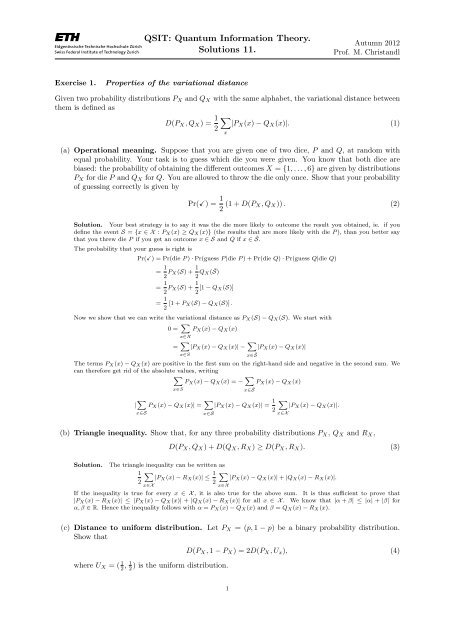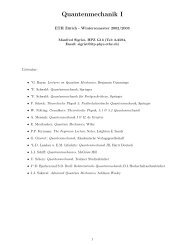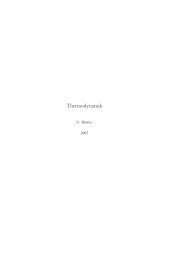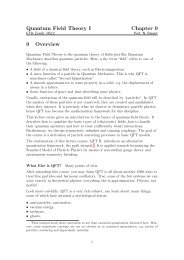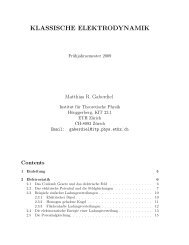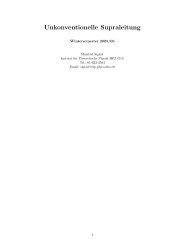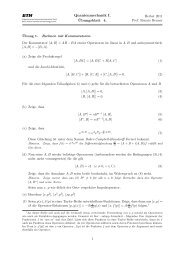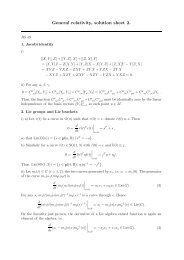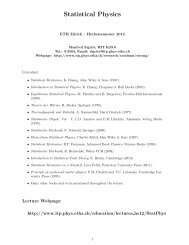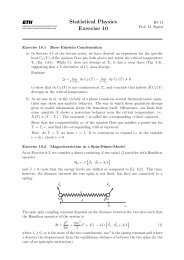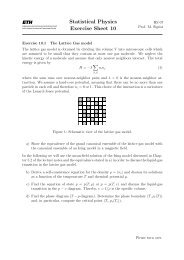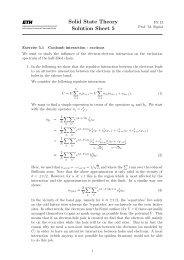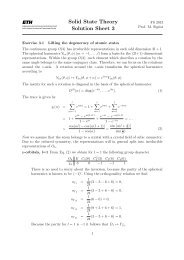QSIT: Quantum Information Theory. Solutions 11.
QSIT: Quantum Information Theory. Solutions 11.
QSIT: Quantum Information Theory. Solutions 11.
You also want an ePaper? Increase the reach of your titles
YUMPU automatically turns print PDFs into web optimized ePapers that Google loves.
Solution. We can write<br />
D(P X , 1 − P X ) = 1 ∑<br />
|P X (x) − (1 − P X (x))| = 1 ∑<br />
|2P X (x) − 1| = ∑ 2<br />
2<br />
x<br />
x<br />
x<br />
∣ P X(x) − 1 2 ∣ = 2 D(P X, U X ) .<br />
(d) Joint distributions. Let P XY be a joint probability distribution, with marginals P X and P Y that<br />
have the same alphabet. Show that D(P X , P Y ) ≤ Pr[X ≠ Y ].<br />
Solution.<br />
D(P X , P Y ) = 1 ∑<br />
∣ ∑ P XY (x, y) − ∑ P XY (x ′ , x) ∣<br />
2<br />
x y<br />
x ′<br />
1 ∑<br />
∣ ∑ P XY (x, y) − P XY (x, x) ∣ + 1 ∑<br />
∣ ∑ P XY (x ′ , x) − P XY (x, x) ∣<br />
2<br />
2<br />
x y<br />
x x ′<br />
= 1 ∑ ∑<br />
P XY (x, y) + 1 ∑ ∑<br />
P XY (x, y) = ∑ P XY (x, y) = Pr [X ≠ Y ] .<br />
2<br />
2<br />
x y≠x<br />
y x≠y x≠y<br />
Exercise 2.<br />
Playing Eve<br />
You are Eve, and are trying your best to thwart Alice and Bob’s plans to share a secret key using the<br />
quantum key distribution protocol BB84. You will hack into their insecure quantum channel, capture<br />
the qubit sent by Alice, measure it in some basis, and then send it to Bob. [Note that this is not the<br />
most general attack possible.] You are trying to pick the best possible basis to measure Alice’s qubit.<br />
Remember that you want to minimize the errors that can be detected by Alice and Bob, while trying to<br />
maxime the number of bits you guess correctly. Let’s try a few different bases. For each case, compute<br />
the fraction of bits that you guess correctly, and the error rate induced in Alice and Bob’s key, after<br />
sifting.<br />
(a) In your first attempt, you will measure all of Alice’s qubits in the Z basis.<br />
(b) In your second attempt, you will pick X or Z at random, with equal probability, for each qubit.<br />
(c) More generally, you can measure in an orthonormal basis of the form<br />
{<br />
cos θ 2 |0〉 + sin θ 2<br />
|1〉, cos<br />
θ + π<br />
2<br />
|0〉 + sin θ + π |1〉<br />
2<br />
For instance, picking θ = 0 gives you the Z basis, while θ = π 2<br />
results in the X basis. What happens<br />
for θ = π 4 ?<br />
}<br />
.<br />
Solution. The solution to this exercise is attached on page 4.<br />
Exercise 3.<br />
Chained Bell inequalities<br />
Consider the following setting. Alice and Bob own one black box each. Alice’s box takes an input a from<br />
a set A = {0, 2, . . . , 2N − 2} and outputs a bit x ∈ {0, 1}. Similarly, Bob’s box takes an input b from a<br />
set B = {1, 3, . . . , 2N − 1} and outputs y ∈ {0, 1}.<br />
We define the following measure of correlations,<br />
I N = Pr(X = Y |A = 0, B = 2N − 1) +<br />
∑<br />
|a−b|=1<br />
Pr(X ≠ Y |A = a, B = b) (5)<br />
We want I N to be small, because then it is possible to show that the outcomes of adjacent inputs a and<br />
b = a ± 1 are the same, and unknown to an adversary, with high probability. [This is a generalization of<br />
the theorem from the lecture, with I 2 ↦→ I N .]<br />
2
(a) We will see a physical example of a family of “black boxes” that achieves I N → 0. Each box<br />
corresponds to a quantum measurement device that acts on a single qubit. The qubits to be<br />
measured, one in Alice’s box and one in Bob’s, are maximally entantled.<br />
Let {|↑〉, |↓〉} be an orthonormal basis for a qubit (for instance the Z basis). Suppose that Alice’s<br />
choices of input a correspond to a POVM {E0 a , E1 a }, on a single qubit, with E0<br />
a is the projector<br />
onto state | a<br />
2N π〉, and Ea 1 is the projector onto state | ( a<br />
2N + 1) π〉, with |θ〉 = cos θ 2 |↑〉 + sin θ 2 |↓〉.<br />
The same holds for Bob’s measurements b. Furthermore, suppose that the POVMs on Alice’s and<br />
Bob’s sides act each on a qubit of the Bell state √ 1 2<br />
(|00〉 + |11〉) .<br />
Show that, in these conditions,<br />
I N = 2N sin 2<br />
π<br />
4N ≤ π2<br />
8N . (6)<br />
Solution. The solution to this exercise is attached on page 7.<br />
(b) How would you adapt the protocol from the lecture to take advantge of this Bell inequality?<br />
Solution. By measuring in such a basis, Alice and Bob can achieve a lower “secrecy” value I N → 0 (for large N)<br />
instead of I 2 , and the two key bits will differ with lower probability.<br />
3
Solution to Exercise 2.<br />
4
Solution to Exercise 2.<br />
5
Solution to Exercise 2.<br />
6
Solution to Exercise 3 (a).<br />
7


